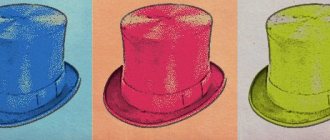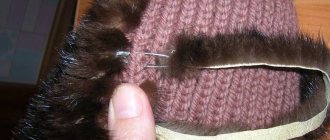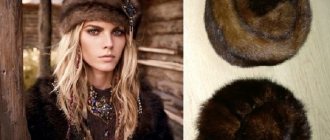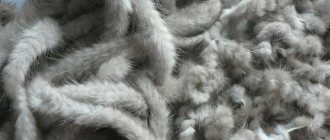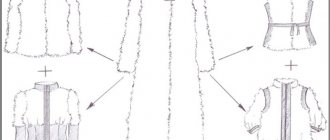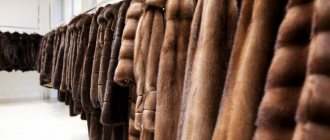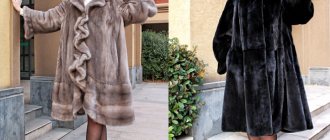You want to buy, sew or knit a hat. But we are not sure if the size was determined correctly. Along what circumference should the measuring tape be applied to ensure accurate measurements? If you take your measurements meticulously, then a headdress you bought or made with your own hands will delight you and be worn with pleasure. Let's find out!
Taking correct measurements
To determine the size of the head, you need to use a soft centimeter.
To determine the size of the head of an adult, you will need a measuring tape or string, fabric tape, a strip of strong paper, or thread. Measurements are taken while sitting, without bending over or hunching. The hair is first untied and gets rid of elastic bands and hair clips that could interfere with the process.
When calculating the size of the cap, they are determined with three main indicators:
- Head circumference. The measuring instrument is circled around the head, placed 2-3 cm above the eyebrows, along the forehead, above the ears and along the most protruding part of the back of the head. The limits of normal values for adults are 51-65 cm. Do not squeeze the skin too much, and increase or decrease the result obtained for good measure.
- Planting depth. This is the space from the back of the head to the forehead. The end of the tape is applied to the point to which the hat is usually moved and led to the protrusion on the back of the head. Indicators vary from 24 to 26.5 cm. They are necessary when sewing and knitting a headdress for a specific person.
- Transverse line. The measuring tape is placed over the ears and passed along the back of the head from temple to temple. The range of values is 25.5-26.5 cm.
If measurements are taken for non-standard hats that are pulled to the middle of the ear, the obtained values are reduced by 0.5-1.5 cm.
Adults need to measure their head size to crochet or knit, sew, or buy a headdress without trying on. For children under one year old, measurements are taken not only to purchase hats, but also to monitor proper development.
A simple hat with knitting needles - what needs to be done before knitting
Before you start knitting, you need to do four things - choose the yarn, knit and measure the sample, determine the size of the hat, calculate the number of loops and rows.
Yarn selection
Let's start with choosing yarn. A universal yarn for a simple knitted hat is considered to be medium-thick yarn with a length of 200 - 240 meters per 100 grams. For an adult hat you will need 150 - 200 grams of yarn, for a children's hat - 100 - 150 grams. more about how to choose the right yarn here.
The recommended knitting needle size for medium-thick yarn is No. 3.5 - No. 4.5. A label attached to a skein of yarn will help you determine more precisely the thickness of your knitting needles. It usually indicates the average knitting density and the recommended size of tools.
Knitting a pattern with knitting needles
The knitting density is determined using the control sample. Therefore, knitting a sample is a mandatory part that can be skipped only if you have previously worked with this yarn and have thoroughly studied its properties.
Determining the size of a headdress for adults
The size of the product is the main factor when purchasing. In Russia, the numerical sizing system on labels and tags clearly coincides with the head circumference, expressed in centimeters. British and American systems are based on inches. However, the most popular is the international system that displays measurements in letters (S, M, L).
Knowing your indicators, you can compare them with the head circumference table for adults, where the smallest size 51 (by international standards XXS, by American and British standards 6 3/4) is 51 cm, and the largest is 65 (XXXXL, 8 1/8 ) is 65 cm:
- size XXS varies between 51-54 cm, 6 3/4;
- XS – 55, 6 7/8;
- S -56, 7;
- M – 57.7 1/8;
- L – 58.7 1/4;
- XL – 59.7 3/8;
- 2XL – 60-64, 7 7/8-8.
The normal head volume for women is 54-61, for men – 58-65. The more accurately the measurements are taken, the more beautiful and harmonious the hat fits. If the size is determined correctly, the product can be purchased without trying on.
Children's sizes
Considering the head size of men and women, you need to look at additional nuances:
- Material and density of the product. Viscose and acrylic hats with a wide weave are prone to stretching, so you need to subtract 1-2.5 cm from the head volume. This is the standard for all hats made from bulky or loose fibers/fabrics. Cotton, cashmere, and wool hats shrink when washed, so you should choose them with a margin of 1-2 cm. If the fabric is dense and does not stretch, there is no need to adjust the indicators.
- View. There are separate head circumference size charts for caps and baseball caps. In addition, they have adjustable elements that allow you to adjust the seating depth and girth.
- Landing. Some people benefit from headwear that covers most of the forehead and ears. Others wear the most open models. In such cases, it is necessary to add or subtract 1-2 cm from the measurements obtained.
- Seasonality. To maintain warmth and comfort, winter options should fit as closely as possible to the head and completely cover the ears.
- Pattern. Knitted hats are purchased by subtracting 1 cm from the girth parameters, taking into account the future stretching of the product.
- Hair volume. If a woman has thick and long hair, the cap should be selected a size larger.
To buy a headdress without first trying on, just measure the circumference of your head and compare it with the size tables. If the product is non-standard, additional parameters must be taken into account.
Calculation of loops for knitting a hat
To calculate the loops and rows, we will use a calculator for knitting hats. It was published on her website in 2000 by the famous designer and knitter Mary Young Smith.
The calculator is designed for knitting in the round; if you decide to knit on straight needles, do not forget to add one edge loop on each side.
It remains to determine the knitting density from the finished sample and find in the table the number of loops that need to be cast on for the desired hat size.
If the table does not contain the size or knitting density you need, then you can take the average value between the nearest cells, but it is better to perform simple calculations.
You can determine the number of loops by multiplying the hat size by the knitting density and dividing the resulting result by 10.
For example, for a hat measuring 43 cm with a knitting density of 17 p./10 cm, you need to dial
73 p = 43 cm * 11 p / 10 cm
Hats are usually started with an elastic band, so the number of stitches cast on should be a multiple of the elastic repeat. If necessary, the number of loops is adjusted downward. Since the elastic is subject to stretching, it is better to use knitting needles that are half the number smaller than for the main part of the hat.
Measuring head circumference in infants
For infants, the volume of the head and chest is measured monthly.
For newborns, the head circumference is measured monthly. Together with other parameters (height, weight, chest girth), the size of the skull indicates compliance with developmental standards. If they deviate greatly from standard numbers, this indicates the development of pathological processes, for example, hydrocephalus, microcephaly. Minor deviations are attributed to genetic features of the structure of the cranial bones.
The most active growth of the skull occurs in the first 3 months of a child’s life and continues until 12 months. In the future, the process of increasing volume does not occur so intensively. On the day of birth, the baby’s head parameters exceed the chest parameters by 2 cm, and closer to 3-4 years they become approximately the same.
Taking measurements proceeds as follows:
- a newborn is placed on the table, a baby older than 6 months is seated in a high chair and given a toy to distract him;
- the measuring tape is placed on the back of the skull so that it runs above the ears along the occipital protuberance;
- connect the starting edge and the end point of the tape above the eyebrow arches;
- compare the obtained numbers with the norms in the table.
To get the most accurate measurement result you need:
- determine the diameter of the baby’s head using the same tape;
- do not put pressure on the head, especially of a newborn baby, since the bones of infants are fragile;
- if the child cries and is worried, try to take the measurement at another, more appropriate moment;
- record results with an accuracy of 1 mm, without rounding numbers;
- keep a diary with anthropometric data, remembering to enter new measurements every month.
Head circumference figures for infants under 12 months should not exceed chest measurements. If a significant deviation from the norm is detected, you should immediately contact your pediatrician.
Knitting a hat with circular knitting needles
Knitting in the round makes the work much easier, since all rows are knitted on the right side. In patterns, the number of purl loops is reduced, and in stocking stitch they are completely absent.
Circular knitting can be done on double-sided knitting needles or on knitting needles with fishing line.
Double needles are sold in sets of 5 pieces. The loops on them are cast on in the usual way and distributed in equal parts onto 4 needles. Then the loops are closed in a circle, the fifth free knitting needle is considered working.
Short circular knitting needles 8–9 cm long, connected with a 40 cm long fishing line, are considered an ideal option for hats. You can also use standard knitting needles 11 - 12 cm long. But you need to take into account that they are not suitable for too small sizes and for covering the top of the head.
To ensure that a step does not form at the very beginning of knitting and the beginning of the hat looks neat, there should be 1 more loops than required for knitting. We close the work in a circle. We carefully check that the canvas does not twist. We knit the first and last of the cast-on loops together. Mark the beginning of the row with a marker.
You need to cast on the hat the number of loops that we determined from the knitting density table. To prevent the edge from curling, knitting begins with an elastic band.
Choosing a headdress for a child
Caps made of cotton fabric need to be purchased a size larger.
When purchasing a hat for a baby, you should focus on the measurement table with the ratio of height and age. The first hat size starts at 35 and is suitable for babies up to 1 month old with a height of 50-51 cm. Then the parameters increase progressively. For example, at 5 years old this is size 51 for a height of 104-109 cm. For a 12-year-old child with a height of 146-151 cm, size 59 is suitable.
For knitted hats for children from 0 to 8 years old, you should look at the tables taking into account head girth and age indicators:
- head circumference 35-40 corresponds to age 0-3 months;
- 42-44 – 3-6 months;
- 44-46 – 6-12 months;
- 46-48 – 1-2 years;
- 48-50 – 2-3 years;
- 50-54 – 3-5 years;
- 52-56 – 5-8 years.
When choosing baby clothes for a newborn boy or girl, you should take into account the rapid growth of the head. In one month it can increase up to 2 cm. For caps with odd circumference parameters, it is better to take one size larger.
How to beautifully close the crown of a simple hat with knitting needles
After the main part of the hat is knitted, they begin to launch it. To beautifully close the crown of the hat with knitting needles, you need to distribute the number of loops into wedges of equal size.
Mary Young Smith's calculator will allow you to close the crown of your cap without calculations. The number of wedges and rows depends on the thickness of the thread and the knitting density. Thin large caps can have up to 12 wedges; they start from the first row of the table.
For volumetric headings, the rows located at the top of the table are omitted. Decrease of loops begins with the row number, with the indicated knitting density.
Reducing stitches on a hat
A simple hat with knitting needles is usually closed with wedges of equal size. By decreasing one loop in each cap wedge, we get a beautiful crown in the form of a spiral. The thinner the yarn, the more twisted the crown becomes. Using a little trick, the spiral can be twisted both to the left and to the right.
- If you close the loops by knitting two stitches together, knitting them to the right, the parts of the cap will have a right slant. With this method of closing, decreases are made at the end of each wedge. The working needle is inserted from left to right into 2 loops at the same time. Then the loops are knitted together behind the front walls.
- In order for parts of the crown to look to the left, it is recommended to make decreases on the first loops of the wedge, closing them with an inclination to the left. Most handicraft publications recommend closing the loops with a pigtail. First, you need to remove one unknitted loop onto a working knitting needle, then knit the next loop and throw it over the removed loop.
I prefer the method of knitting two loops together, tilting to the left and turning the loops. The loops on which the decreases will be made are removed one at a time from the front wall, not knitted onto a working needle. When removed, each hinge rotates 180 degrees. The inverted stitches are returned to the left needle. After which a working needle is inserted into them from right to left, and the loops are knitted together with a knit stitch.
Additional recommendations
Children's hats should be made from natural fabrics or threads.
Modern hats combine not only functionality, but also a beautiful appearance. But if for women the priority is a tribute to fashion, then for children's hats comfort and convenience are important.
Children's clothing
Children's products must be carefully selected in size. If you put a very large cap on a baby, it can be life-threatening, since when you turn your head, the product can slide down onto your face and make breathing difficult. The same rules apply to choosing a winter hat. A model that is too tight will begin to squeeze the head and create discomfort, while a model that is too spacious will not retain heat, which will lead to ear disease.
All necessary information about the product is indicated on the tag or sewn-in label.
The inner surface of a baby's hat should be made from natural fabrics to eliminate the possibility of allergies and not have rough seams that rub the baby's delicate skin.
Women's clothing
Hats and berets almost never go out of fashion.
When choosing a women's headdress, you should pay attention not only to the girth and depth indicators, but also to the appearance and color of the product. Berets and hats are considered the most popular among Russian women. Berets go with classic clothing styles, and hats never go out of style. However, when choosing a hat you need to be guided by several nuances:
- Narrow options are suitable for petite representatives of the fairer sex, wide-sex models are suitable for tall ones;
- if your hair is curly, you should opt for rounded soft hats;
- products with strict shapes look ideal on women with sharp facial features;
The color of the headdress must match the elements of clothing. Beige tones emphasize the beauty of brunettes, and the green color of the product gives expressiveness to emerald-colored eyes.

